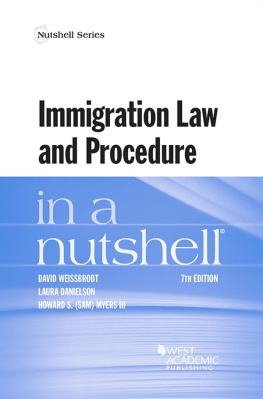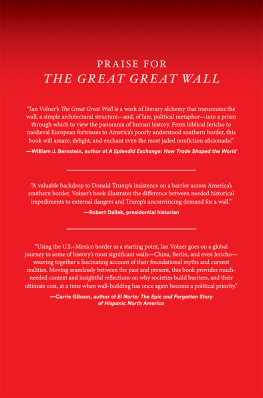Printed in the U.S. by Maple Press
For my fellow journalists in Mexico. For those who
died denouncing injustice, and for those who have
been persecuted and killed for telling their stories.
One night in December 2012, Jos Luis Benavides, Kent Kirkton, and Julin Cardona came over to my house. They had barely walked in the door before Benavides said, I have the story for your next book. That book is We Built The Wall.
I made my first trip to El Paso and Jurez in early 2013, and I would go two more times over the next two years. There, I discovered the generosity and clarity of purpose of Carlos, Sandra, and Alejandra Spector, and the boundless courage of those they represent, overcoming their fear, anger, and indignation to rebuild their lives, while continuing to demand justice.
Thanks to Sara Salazar de Reyes, Sal Reyes, Gloria Lpez, and their families, for opening their homes and their hearts to me. To Martn Huramo, Carlos Gutirrez, Alejandro Hernndez Pacheco, Cipriana Jurado, Sandra Rodrguez Nieto, Irma Casas, Rubn Garca, Arturo Bauelas, Claudia Amaro, and Yamil Yujar; sisters Nitza, Mitzi, and Deisy Alvarado; Roco Hernndez, Santiago Garca, Erick Midence, and Enrique Morones, for sharing moments from their lives, their experience, and their knowledge of both sides of the border. To Melissa del Bosque, Julin Cardona, and Marcela Turati for their extraordinary documentation work, and to my journalist colleagues at El Diario de Jurez for being a beacon of light to better understand life in the complex El PasoJurez region. To immigration lawyer Daniel M. Kowalsi for sharing information necessary to understand the tangled web of U.S. immigration law.
To Diane Stockwell, I owe gratitude not only for her complicity and energy in getting this book published, but also for her sensitivity in understanding that every word spoken by a victim of forced migration has meaning. To Andrew Hsiao and the team at Verso Books, I am grateful to you for raising the voices of the protagonists in this book so they will reach those who have yet to hear them.
Thanks to Edgar Krauss, Alfredo Corchado, and Angela Kocherga, for their encouragement at the beginning of this project, and to Willivaldo Delgadillo and Toni Piqu for their critical readings. To Jaime Abello Banfi, Natalia Algarn, and the Fundacin Nuevo Periodismos journalistic books workshop for giving me the chance to work on the first draft of this book under the masterful watch of Martn Caparrs. To Diego Fonseca, Catalina Lobo-Guerrero, Ander Izagirre, Roberto Valencia, Claudia Jardim, Andrs Hernndez, Esteban Castro, and Cecilia Lanza, for their thoughtful readings and incisive critiques.
Jos Luis Benavides and Kent Kirkton have my admiration and warm appreciation for their intelligence and ability to feel injustice against others as if it were theirsand my gratitude for making room for me in their little red pickup truck and taking me along on their tour through the borderlands.
A few days before New Years Eve in 2013, Diego Sedano and I got into our car and set off for Fabens, Texas, to go talk to Sal Reyes and his family. A year later, we drove even further, from Los Angeles to San Antonio, to talk to the three young sisters who still hope their mother will come back one day. For the stories, the tears, and the songs we shared on those days driving down Highway 10, this is Diegos book, too.
Ann Donnellys name echoed all over social media the night of January 28, 2017. Donnelly had been a federal district court judge for just over a year when a ruling from her court in Brooklyn, New York, made her the first judge to block an executive order by President Donald Trump.
The executive order, signed by Trump the day before on Friday, January 27, was announced as a temporary cancellation of permission to enter the United States for citizens of seven countries: Libya, Syria, Iraq, Iran, Sudan, Yemen, and Somalia, with the alleged aim of protecting the country from terrorism. Although the order defined those barred from entering by their nationality, it was widely known as the Muslim ban, a phrase popularized by Trump himself during his presidential campaign, because Islam was the predominant religion in the seven countries cited.
Of the twenty-three executive orders signed by Trump during his first twelve weeks in office, this was the most polemic, stirring the strongest reaction from U.S. citizens. Within just a few hours, large crowds descended on the biggest airports in the country to protest the measure and to show support for people being detained upon arrival, including permanent U.S. residents who had temporarily traveled to their country of origin. Syrian refugees scheduled to arrive in the United States that weekend were detained; an infant girl from Iran traveling to the United States for life-saving heart surgery was not allowed to enter the country. Within a few days, federal courts in other cities had also blocked the order. For the first time in many years, the United States took a hard look at itself and its policies of accepting and excluding refugees, asylum seekers, immigrants, and people from other countries in general.
It was probably about time. For decades, the United States has promoted itself to the rest of the world as a democratic country, with an open-arms policy that affirms diversity, which has very little to do with how the nation actually shapes its policies around immigration, refuge, and asylum.
In spite of being the country with the largest number of immigrants in the worldalmost 50 million people living in U.S. territory were not born therethe United States has a smaller percentage of immigrants in relation to the general population than other countries. Immigrants comprise 14 percent of the U.S. population, compared with 22 percent in Canada and 28 percent in Australia; countries that have openly acknowledged their need for foreign labor have reached figures as high as 75 percent in Qatar and 88 percent in the United Arab Emirates. Even in Spain, a country experiencing large-scale immigration only recently, 13 percent of the population are immigrants, just one percentage point less than the United States.
Another image the United States sells to the world is the melting pot, referring to its ethnic diversity. Compared with other countries, however, it is not a leader in that sense either. In terms of diversity, once again other countries such as Canada, Denmark, and the United Kingdom have higher indices. In the United States, one of every four immigrants comes from a single country, Mexico. In other destination countries popular with immigrants, mainly in Europe, migration comes from a wider, more diverse range of countries.











